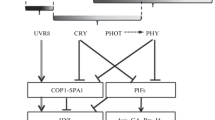Abstract.
To keep track of fluctuations in spectral composition and intensity of incoming sunlight, plants engage a plethora of photosensory pigments. Absorption of light by these photoreceptors sets in motion signaling cascades that ultimately influence the plant's physiology. Many light-controlled processes are based on modulation of gene activity in response to changes in irradiation. The molecular basis of this regulation and the downstream components transducing signals from the photoreceptors are not fully understood yet, but recent evidence suggests that some of those routes are rather short. The phytochrome photoreceptors have been found to influence light-responsive promoters by direct contact with transcription factors. Additionally, the cryptochrome blue-light receptors directly interact with a key repressor of photomorphogenesis, suggesting that light activation of photoreceptors could initiate photomorphogenesis through posttranslational regulation. This review focuses on recent insights into photosensory transduction mechanisms as well as on our current understanding of light entrainment of the endogenous clock.
Similar content being viewed by others
Author information
Authors and Affiliations
Additional information
Electronic Publication
Rights and permissions
About this article
Cite this article
Fankhauser, C., Staiger, D. Photoreceptors in Arabidopsis thaliana: light perception, signal transduction and entrainment of the endogenous clock. Planta 216, 1–16 (2002). https://doi.org/10.1007/s00425-002-0831-4
Received:
Accepted:
Issue Date:
DOI: https://doi.org/10.1007/s00425-002-0831-4




